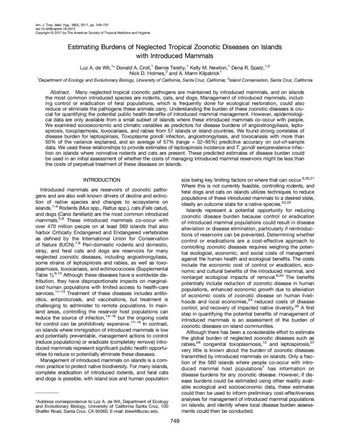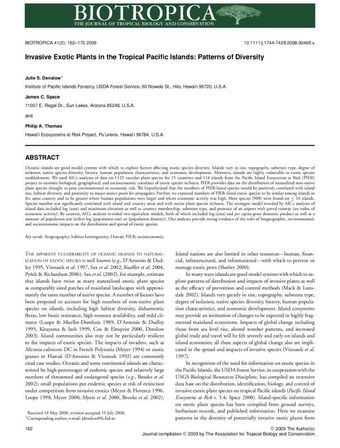Connect with Library of the Czech Academy of Sciences
Contact this content partner to get more information about this item.
Invasibility of tropical islands by introduced plants
- Description:
- All else being equal, more isolated islands should be more susceptible to invasion because their native species are derived from a smaller pool of colonists, and isolated islands may be missing key functional groups. Although some analyses seem to support this hypothesis, previous studies have not taken into account differences in the number of plant introductions made to different islands, which will affect invasibility estimates. Furthermore, previous studies have not assessed invasibility in terms of the rates at which introduced plant species attain different degrees invasion or naturalization. I compared the naturalization status of introduced plants on two pairs of Pacific island groups that are similar in most respects but that differ in their distances from a mainland. Then, to factor out differences in propagule pressure due to differing numbers of introductions, I compared the naturalization status only among shared introductions. In the first comparison, Hawai‘i (3700 km from a mainland) had three times more casual/weakly naturalized, naturalized and pest species than Taiwan (160 km from a mainland); however, roughly half (54%) of this difference can be attributed to a larger number of plant introductions to Hawai‘i. In the second comparison, Fiji (2500 km from a mainland) did not differ in susceptibility to invasion in comparison to New Caledonia (1000 km from a mainland); the latter two island groups appear to have experienced roughly similar propagule pressure, and they have similar invasibility. The rate at which naturalized species have become pests is similar for Hawai‘i and other island groups. The higher susceptibility of Hawai‘i to invasion is related to more species entering the earliest stages in the invasion process (more casual and weakly naturalized species), and these higher numbers are then maintained in the naturalized and pest pools. The number of indigenous (not endemic) species was significantly correlated with susceptibility to invasion across all four island groups. When islands share similar climates and habitat diversity, the number of indigenous species may be a better predictor of invasibility than indices of physical isolation because it is a composite measure of biological isolation.
- Format:
- text
- Collections:
- Library of the Czech Academy of Sciences
- Content partner:
- Library of the Czech Academy of Sciences
- Availability:
- Not specified
-
Copyright status: Share, modifyFind out more about what you are able to do with this itemMore informationLibrary of the Czech Academy of Sciences has this to say about the rights status of this item:
http://creativecommons.org/publicdomain/mark/1.0/
What can I do with this item?Non-infringing useNZ copyright law does not prevent every use of a copyright work, and this item may be hosted by an international institute or organisation. You should consider what you can and cannot do with a copyright work.Share itThis item is suitable for copying and sharing with others, without further permission.Modify itThis item is suitable for modifying, remixing and building upon, without further permission.Check about commercial useYou'll need to confirm with the copyright holder using this item for commercial purposes.
Related items
Welcome and warm Pasifik greetings
The information on this site has been gathered from our content partners.
The names, terms, and labels that we present on the site may contain images or voices of deceased persons and may also reflect the bias, norms, and perspective of the period of time in which they were created. We accept that these may not be appropriate today.
If you have any concerns or questions about an item, please contact us.

